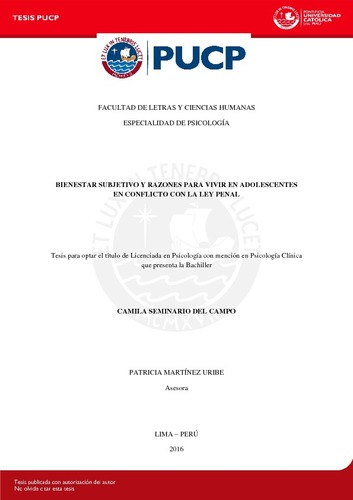| dc.contributor.advisor | Martínez Uribe, Patricia | es_ES |
| dc.contributor.author | Seminario del Campo, Camila | es_ES |
| dc.date.accessioned | 2016-08-04T15:12:26Z | es_ES |
| dc.date.available | 2016-08-04T15:12:26Z | es_ES |
| dc.date.created | 2016 | es_ES |
| dc.date.issued | 2016-08-04 | es_ES |
| dc.identifier.uri | http://hdl.handle.net/20.500.12404/7168 | |
| dc.description.abstract | La presente investigación tiene como objetivo explorar la relación entre el Bienestar Subjetivo y las Razones para Vivir en un grupo de adolescentes entre 14 y 18 años que se encuentran internados en un centro de diagnóstico y rehabilitación de menores en Lima. Para ello, se utilizó la Escala de Afecto Positivo y Afecto Negativo (PANAS) para medir el componente afectivo de Bienestar Subjetivo, la Escala de Satisfacción con la Vida (SWLS) para medir el componente cognitivo del Bienestar Subjetivo, y el Inventario de Razones para Vivir para adolescentes (RFL-A). Además, se analizaron algunas características propias de la población, como la edad, grado de instrucción, tiempo de permanencia en el centro, relación con compañeros, visita de familiares, entre otras. Los resultados mostraron que existe una correlación positiva y significativa entre el Afecto Positivo y tres áreas del RFL-A: Optimismo hacia el futuro, Alianza Familiar y Autoaceptación. | es_ES |
| dc.description.abstract | The present study aims to explore the relationship between Subjective Well-being and Reasons for Living in a group of adolescents between the ages of 14 and 18 interned in a diagnostic and rehabilitation center for minors in Lima. The instruments used were the Positive Affective Negative Affective Schedule (PANAS) to measure the affective component of Subjective Well-being, the Satisfaction With Life Scale (SWLS) to measure the cognitive component of Subjective Well-being, and the Reasons For Living Inventory for Adolescents (RFL-A). It also analyzes variables such as age, level of education, length of internment, relationship with mates, family visit, among others. The results showed a positive and significant correlation between Positive Affective and three areas of RFL-A: Future Optimism, Family Alliance and Self-Acceptance. | es_ES |
| dc.language.iso | spa | es_ES |
| dc.publisher | Pontificia Universidad Católica del Perú | es_ES |
| dc.rights | Atribución-NoComercial-SinDerivadas 2.5 Perú | * |
| dc.rights | info:eu-repo/semantics/openAccess | es_ES |
| dc.rights.uri | http://creativecommons.org/licenses/by-nc-nd/2.5/pe/ | * |
| dc.subject | Bienestar | es_ES |
| dc.subject | Afecto (Psicología). | es_ES |
| dc.subject | Satisfacción con la vida | es_ES |
| dc.subject | Delincuencia juvenil. | es_ES |
| dc.title | Bienestar subjetivo y razones para vivir en adolescentes en conflicto con la ley penal | es_ES |
| dc.type | info:eu-repo/semantics/bachelorThesis | es_ES |
| thesis.degree.name | Licenciado en Psicología Clínica | es_ES |
| thesis.degree.level | Título Profesional | es_ES |
| thesis.degree.grantor | Pontificia Universidad Católica del Perú. Facultad de Letras y Ciencias Humanas. | es_ES |
| thesis.degree.discipline | Psicología Clínica | es_ES |
| renati.discipline | 313026 | es_ES |
| renati.level | https://purl.org/pe-repo/renati/level#tituloProfesional | es_ES |
| renati.type | http://purl.org/pe-repo/renati/type#tesis | es_ES |
| dc.publisher.country | PE | es_ES |
| dc.subject.ocde | https://purl.org/pe-repo/ocde/ford#5.01.00 | es_ES |






